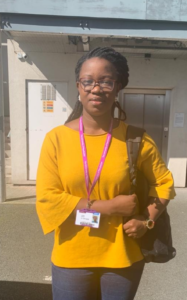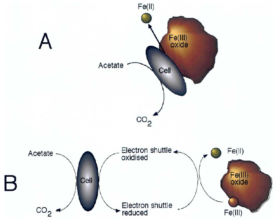Lordina Eshun

Fig. 1: Me at Manchester, England, UK
I am Lordina Ekua Eshun, ESR 5 and hosted by the University of Manchester, England, UK. Specifically, I am working in the Geomicrobiology group of the Department of Earth and Environmental Sciences. The Geomicrobiology group focusses on the environmental impact of microbial processes in a wide range of systems (both natural and engineered). The group is equipped with a state of the art laboratory in the Williamson Research Center for Molecular Environmental Sciences. I count it a privilege to work in this Research Center. I have been working in Manchester since the last week of January 2020 on the development of novel biotechnological routes for the production of phosphate containing agricultural fertilizers. I am supervised by Prof. Jonathan Lloyd and co-supervised by Prof. Samuel Shaw and Dr. Victoria Coker at the University of Manchester. Within P-TRAP, my project is also co-supervised by Prof. Antonio Delgado (Universidad de Sevilla, Spain) and Dr. Andreas Voegelin (EAWAG, Switzerland).
My research is focused on using microbial-based processes to convert P-loaded Fe(III) oxides into Fe(II) phosphate, Vivianite and other valuable minerals. Iron oxides are ubiquitous in the environment and microorganisms are able to transform these Fe oxides through reductive processes into Fe bio-reduced minerals. An example is the reduction of Fe(III) oxides into magnetite nanoparticles by Fe(III) reducing bacteria also called Dissimilatory metal-reducing microorganisms. This process is believed to take place in sediments, aquatic systems (both fresh and marine waters), subsurface and areas with no/lower oxygen levels. The mechanism of this Fe reduction is illustrated in Fig. 1 below.

Fig. 1: Microbial reduction mechanism of insoluble Fe(III) oxide into Fe(II) through (A) direct contact with the bacterial cell surface and (B) extracellular electron shuttle (Lloyd et al., 2003a, 2003b).
Biological systems (including surface water bodies, agricultural run-offs, ditches, sediments etc.) have considerable amount of phosphorus which at higher levels trigger excessive algal growth known as Eutrophication. Eutrophication affects aquatic organisms as it reduces the dissolved oxygen content in the water.
When phosphorus and Fe(II) are present in a system, they bind together to form either the Fe(II) phosphate mineral vivianite or other Fe(II)-P bio-reduced minerals. Transformation of insoluble Fe(III) oxides, unlike soluble Fe(III) oxides, into vivianite by Fe(III) reducing bacteria for use as fertilizer has not receive much attention in recent times although some researchers have found vivianite as secondary products of their experiments performed under reduced conditions (in the presence of phosphate). My research will therefore optimize the sorption of phosphate onto Fe(III) oxides and monitor the subsequent bioconversion to vivianite. We will make use of waste Fe sludge, recycled materials from wastewater treatment and bioreactor systems for the bio reduction process.
Field testing of the produced vivianite and other Fe-P biominerals will be done through secondment to Fertiberia (an agricultural and industrial company) and University of Seville in Spain. During these secondments, field trials through pot experiments will be conducted to determine the effectiveness of the produced biomaterials as phosphate fertilizer on some agricultural crops. Hopefully, an alternative to the current phosphate fertilizers can be developed. This will also give me the opportunity to collaborate with Tolulope (ESR 8) in the University of Seville as well as the industrial company Fertiberia. Another secondment will take place at EAWAG in Switzerland where I will focus on characterization of the Fe-P biomaterials. Here, Synchrotron based techniques will be used for the Fe mineral characterization. I will also collaborate with other ESRs such as ESR 2, 4, 6 and 7. This will encourage mutual learning among the group, and I am very happy about that.
About myself, I am a Ghanaian with a BSc degree in Environmental Sciences from the University of Cape Coast. I also hold an MSc degree in Environmental Science (specialized in Environmental Technology) from Wageningen University, the Netherlands. I got the opportunity to do my MSc thesis and internship at the European center of excellence for sustainable water technology (Wetsus) in Leeuwarden, The Netherlands. My thesis was about investigating the effect of increasing Fe dosing on the vivianite content in a wastewater treatment plant (Nieuwveer WWTP) in Breda, The Netherland whereas my internship was focused on the removal of phosphonate- based antiscalant by electrofloculation. Working with the Phosphate recovery theme (specifically ViviMag) at Wetsus motivated my interest in exploring more options in phosphate recovery to help tackle the global issue of phosphorus decline. This, indeed, is one of the reasons why I feel privileged to be a part of EU H2020 P-TRAP project. Also, working with such experienced professors within Geomicrobiology group and P-TRAP will be invaluable for my training. It is my hope that interesting results will be obtained from the research.
I enjoy singing whiles cycling. I developed my cycling abilities whiles studying in the Netherland. I love the Dutch for their zeal for cycling. Aside singing and cycling, I also love dancing, cooking, sporting and traveling with friends. I hope to keep you posted on our work!
References
Lloyd, J. R. (2003a): Microbial reduction of metals and radionuclides, FEMS Microbiology Reviews, 27(2–3), 411–425. https://doi.org/10.1016/S0168-6445(03)00044-5
Lloyd, J. R., Lovley, D. R., & Macaskie, L. E. (2003b): Biotechnological Application of Metal reducing Microorganisms. Advances in Applied Microbiology, 53, 85–128. https://doi.org/10.1016/S0065-2164(03)53003-9

